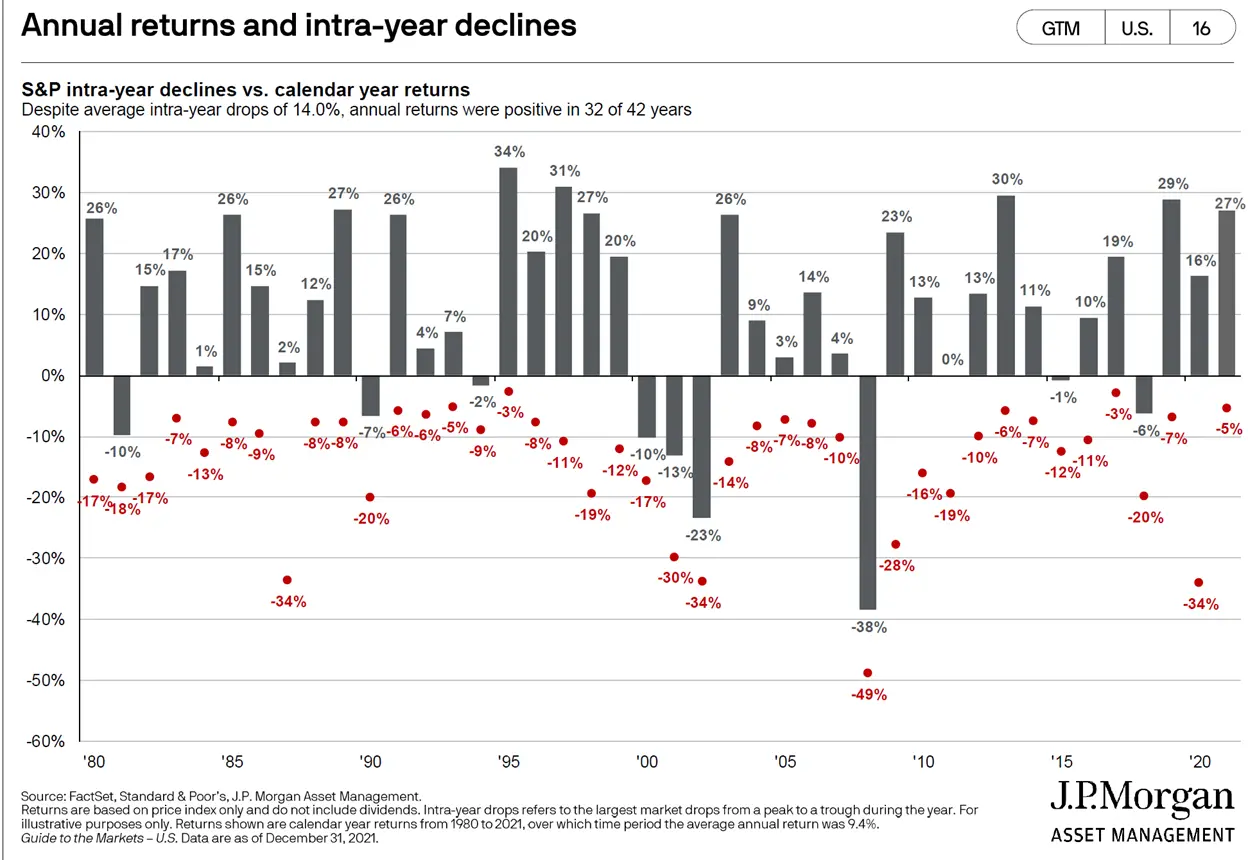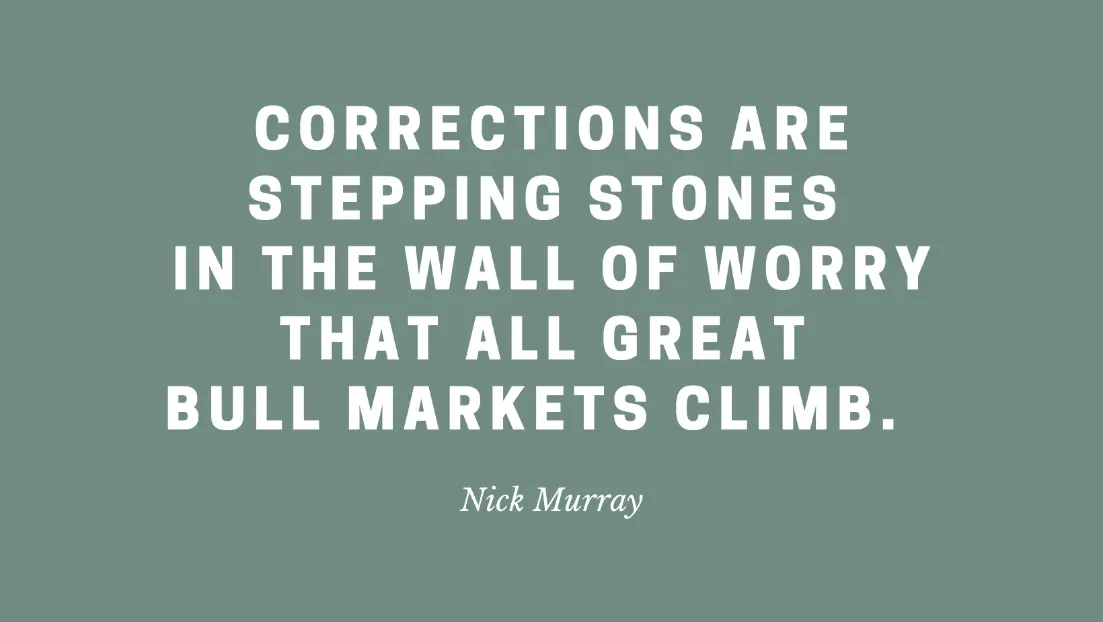
By: Jeff Bernier, CFP®, ChFC, CFS
Jason Zweig of the Wall Street Journal once said that his job is to write the same thing over and over without anyone realizing it. As I sat down to write this piece, I am feeling the same way. How many times have I written a piece to bring perspective during times of great uncertainty and a market correction? Since the average intra-year drawdown of the S&P 500 index in the last 94 years has averaged around 16%[i], I am guessing I have written this kind of communication approximately once a year? By the way, markets ended the year in positive territory in 75% of those years.
With the Russian invasion of Ukraine, new worry has been created.
Ben Carlson wrote an excellent piece a few days ago where he listed some of today’s worries and discussed 3 ways one might react to a market correction. You can read his full article by clicking here.
His list included:
|
Russia is going to war with Ukraine |
We’re in arguably the craziest housing market ever |
Growth stocks are crashing |
|
Inflation is at its highest level in 4 decades |
Interest rates are finally starting to rise |
The stock market is in the midst of a correction |
|
The Fed is tightening monetary policy |
There are labor market and supply chain shortages |
And we’ve been in a pandemic for going on two years now |
We always have “something” to worry about. And, of course, our friends in the media will make sure we are acutely aware of each one on 24 x 7 news, internet sites, finance magazines and podcast. Each item on the list above is like musical chairs where items come off the list and new ones are added all of the time. If I pull versions of this message from past years, I am sure I will find a list with a different set of things to worry about.

The conflict between Russia and Ukraine is an important reminder that geopolitical risks are a part of investing. These events and the economic implications can affect investment markets in many ways. Current market prices quickly incorporate expectations about the effects of these events on economies and companies. As you can see in the illustration from Vanguard, investors often liquidate securities during these episodes which leads to market downturns. As you can see however, once the dust settles, these sell-offs are frequently short lived.
By the time you read this, the broader equity markets may be in a correction (generally defined as a 10% decline from the previous high). Or they may not. I don’t know if you’ve noticed, but markets are a bit volatile of late…like the last 100 years! As of February 23, the tech heavy NASDAQ index was approaching “bear market” territory – down 18.81% from it’s November high.
As I mentioned previously, market corrections are a common occurrence. Regarding the corrections ultimate depth, we can make two important observations: 1) No matter how many pundits opine in the media, it can’t be predicted and 2) To long-term, goal-focused investors, it cannot matter.

As you can see, data from JP Morgan Asset Management shows that since 1980, on a calendar year basis, stocks have been positive in 32 out of 42 years – 76% of the time – yet had average intra-year declines averaging 14%. Therefore, if you cannot ride out an intra-year equity market decline of close to 14% every year, and a decline averaging twice that, about one year in five (since 1945, there have been 14 declines of 20% or more —one about every 5.4 years[ii]) – your risk tolerance may make it difficult to be an equity investor. Of course, if you have a diversified portfolio of both stocks and bonds, your temporary declines would be smaller.
For those still in the accumulation phase of life, I encourage you to regard this and all declines as “Heaven sent”, in that they enable you to accumulate shares at marked down prices. The media’s correction is the accumulator’s sale.
For those in the distribution phase, we generally recommend that you keep emergency reserve and short-term portfolios holding cash to allow you to financially and psychologically weather the storm.
We continue to recommend that your portfolio remains a servant to your financial plan which should be derived from your most cherished financial goals. Goals – Plan – Portfolio. You don’t see current events anywhere in that progression. Why? In my experience, all successful long-term investors are continuously acting on a plan. Most failed investors that I have encountered were continually reacting to current events – and usually in the wrong direction.
Help for the people of Ukraine
While this commentary was written to encourage healthy investor behavior to our clients and readers, I do not want to end without expressing our concern for the courageous people of Ukraine.
Like you, we are sad to see the impact of this conflict on the people of Ukraine. The images and news are heartbreaking: the loss of life, devastation to property, the possibility of the loss of their way of life and basic freedoms, families being separated with some left behind to fight. It is natural for us to concern ourselves with how all of this affects us. However, I am hoping we all pause to recognize how fortunate we are and to offer prayers and support to those in need if we are able.
If you are looking for ways to financially assist, below find a few options to consider.
- My good friends, Bill and Paula Lohnes, lead a local ministry that has partnered for years with pastors in Ukraine. You can read their story and how they are assisting here by clicking on this link.
- The National Christian Foundation provides a link to charities on the frontlines in Ukraine. You can check them out by clicking on this link.
- The International Committee of The Red Cross has a page dedicated to the conflict and ways you can help. You can read more by clicking here.
[i] https://awealthofcommonsense.com/2022/01/this-is-normal/
[ii] https://www.hartfordfunds.com/practice-management/client-conversations/bear-markets.html








